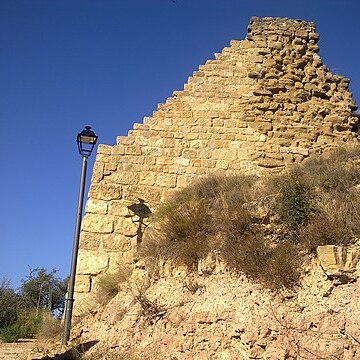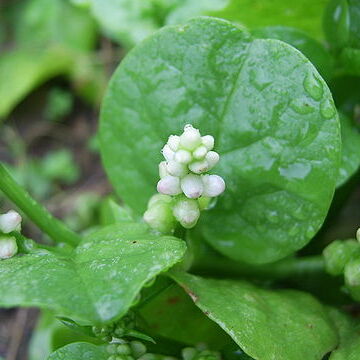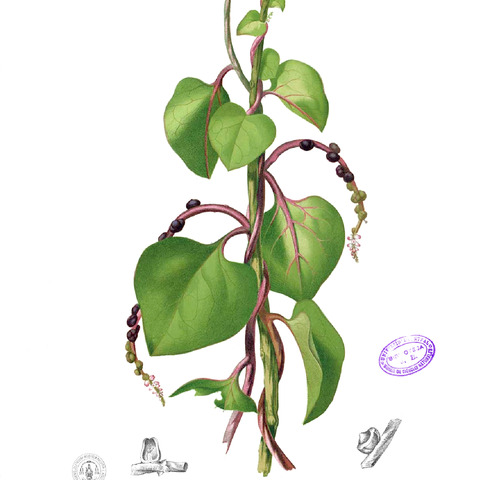Twining rhizomatous herbs, climbing or procumbent, with succulent stems and soft leaves. Inflorescence axillary, spicate, the axis stout and fleshy, occasionally branched. Flowers sessile, not or scarcely opening (cleistogamous or weakly chasmogamous), bisexual, scentless to humans; bracteoles 2, fleshy, adnate to perianth. Sepals 2. Petals 5, obtuse, usually connate for half or more of their length, fleshy, persistent in fruit. Stamens 5, inserted near top of perianth tube, not emergent; anthers dorsifixed, longitudinally dehiscent. Ovary: ovule 1; style 3-fid; stigmas linear. Fruit berry-like or nut-like with a solitary seed, enclosed in the persistent and sometimes fleshy perianth and sepals.
Herbs twining, annual or biannual. Spikes axillary; rachis long, thick. Bracts minute. Bracteoles and urceolate perianth adnate, ovoid or oblong, opening very little in anthesis, fleshy and enclosing the fruit after flowering. Flowers sessile; perianth segments short, fleshy, blunt, ridged on back, hardly opening at anthesis, not wing-shaped in fruit. Stamens included; filaments inserted near apex of perianth tube, very short, erect in bud; anthers dorsifixed, or versatile. Styles 3; stigmas linear. Utricle globose, fleshy. Embryo spiral; cotyledons large, thin.
Twining subsucculent herbs with long much-branched stems. Leaves alternate; lamina ovate, entire. Flowers hermaphrodite, sessile, white or coloured, in axillary spikes or panicles of spikes. Bracteoles 2, united into a 2-lipped cup adnate to the perianth. Perianth urceolate or wide open, fleshy; lobes 5, short, incurved, or almost free and spreading. Stamens 5, inserted near the top of the perianth-tube. Ovary ovoid, free; styles 3, or 1 deeply trifid or obsolete; stigmas 3, linear. Fruit membranous, one-seeded. Seed globose; embryo spiral; endosperm scanty.
Glabrous vines or herbs; stems sometimes succulent; rhizomes without tubers. Leaves sessile or shortly petiolate, succulent. Inflorescences terminal or axillary, erect spikes or panicles; rachis often thick, fleshy; flowers sessile; bracteoles 4, unequal. Flowers almost always cleistogamous; tepals 5, pink, red or white, basally connate, imbricate, urceolate, fleshy and enlarging in fruit; stamens 5, filaments straight in bud, anthers dorsifixed, extrorse; styles 3. Fruit baccate, fleshy, maroon or black; seed subglobose.
Succulent rhizomatous herbs. Flowers bisexual, in simple or occasionally branched spikes. Bracts minute, caducous. Bracteoles and urceolate perianth connate, fleshy, accrescent, ovoid, very little opening in anthesis, after flowering very fleshy and enclosing the fruit, forming a pseudoberry. Stamens included, filaments very short, inserted near the top of the corolla-tube, erect in bud; stamens dorsifixed, versatile. Perianth segments short, blunt. Styles 3, stigmas linear. Embryo spiral; cotyledons large, thin.
Herbs or vines, stems sometimes thick and succulent, glabrous; roots not tuber
Inflorescence of axillary spikes or panicles of spikes.
Bracteoles 2 connate into cup appressed to perianth.
Styles 3 or 1 deeply trifid.
Fruit globose, membranous.
Leaves petiolate, entire.
Embryo spirally twisted.
Stems long, branching.
Flowers hermaphrodite.
Ovary ovoid, free.
Perianth fleshy.
Stigmas linear.



